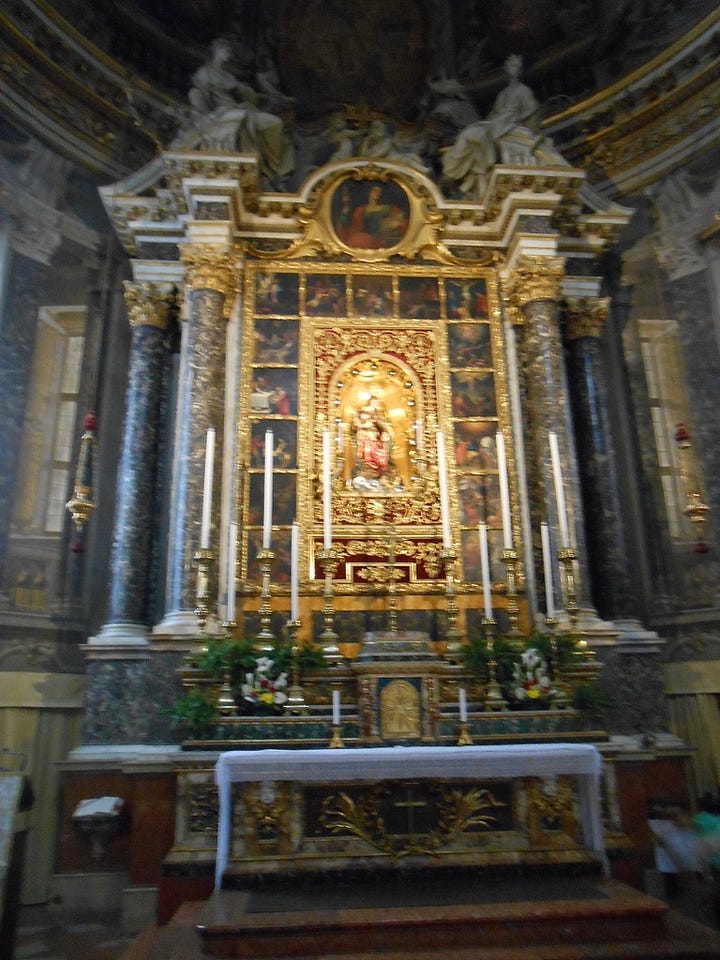
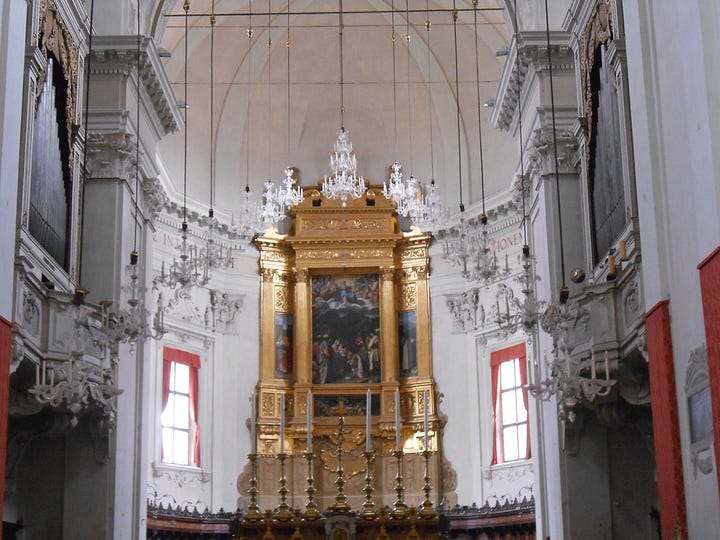
I saw two dead women today: Saint Catherine of Bologna (Caterina Vigri, 1413-1463) and Blessed Elena Duglioli (1472-1520). Both of their bodies are presented to churchgoers “uncorrupt” at the Santuario del Corpus Domini and the Chiesa di San Giovanni in Monte, respectively.
I am increasingly becoming fervently Catholic. I am not Catholic, I’ve been baptised and confirmed into the Church of England, but there is something so alluring about uncorrupt dead women surrounded by gold. I went to four churches today, and had lots of thoughts, and here are some of them.
Starting at the Corpus Domini, after a walk through Piazza Maggiore and its associated crowded little streets on a hot afternoon. The entrance surprised me, the street is narrow so you don’t have long to view and expect the façade before the doorway is right in front of you. Oh, hi. I didn’t notice how fabulous the façade was until leaving and looking back. For the first half second of entering, as I pushed the door closed behind me, I saw no one else in the church, felt the cool of the large stone-walled space, and felt completely at peace to relish and be pseudo-Catholic alone. But I was pushing the door into an English couple who also wanted to get inside, and I was not alone.
On the left before the altar is a side chapel with a little window through which you can catch a sneak peek at Catherine without being in the room with her. But once you’re in the room, other than a glass box and many layers of decoration, there isn’t much to hide behind for Catherine. The room is small and chocked full of things, mostly gold. I sit on one of four chairs, and the room is just me and four women (+Catherine) sitting in dead silence so that I am a bit mortified to be flipping pages in my little notebook and scribbling. The only other sonar punctuation is the woman in the middle sitting straight across from Catherine who keeps yawning, and in a way that is more like a repeated sharp, long breath than a sing-song yawn. After 6 yawns, I wonder if she is doing it on purpose. I think, “no one is forcing you to be here, go home and take a nap.” But when she gets up, she goes up close to Catherine and pays a very intimate respect to her, including blowing her little kisses, so I retract my negative assessment of her yawns as uncaring. A man arrives, disrupting our little homosocial scene, and stands next to me as his laboured breathing disrupts, also, our relative silence
I keep not looking at Catherine, I don’t really know how to look at her. She is this rubbery dark-skinned thing, not particularly glistening, certainly not alive or close to it. She is surrounded by so much splendour, but she is wearing her habit with humility (I think of the reliquary of Sainte-Foy, these sitting women are very different). There is a frescoed ceiling, a fabulous gold and red brocade being draped around her by angels, two sculpted musicians, and on the walls various relics from other saints “collected, mounted, and identified like butterflies” (Jeryldene Wood, Women, Art and Spirituality, p. 122). Lots of other things to be distracted by. On the left wall, surrounded by preserved pieces of bone and teeth, is the Madonna of the Garnet Apple which Catherine painted. How strange to see an artwork in the same room and its artist. How strange to see an artwork from the 15th century in the same room as the visible, shrivelled body of its centuries-dead artist.
After being in there for a decent amount of time, once I am the only one left in the room, the attendant whose job, I assume, is telling people not to take pictures with flash brings me, without prompt, a piece of paper with the key information about Catherine’s life and miracles. “Italiano o inglese?” The paper is in English. “Tutte le due ma…va bene...grazie.” Catherine of Bologna, or Catherine de’ Vigri, was an Italian nun, founder, and first abbess of the Poor Claires monastery of Corpus Domini in Bologna. Born: September 8 1413, Bologna. Death: March 9, 1463, Bologna…1 year before she died she heard an angel singing in the garden who said “The Glory of God will be seen in you”…Catherine dies invoking the name of Jesus 3 times…she was exhumed and found intact and perfumed, only a little crushed in the face and nose, which soon miraculously recomposed…
The English couple, as they leave, say “gracias” to the attendants three times.
I leave and head in the direction of San Giovanni in Monte, but as I reach San Domenico, with my mind on monks and nuns, I can’t help but stop by. Unlike Corpus Domini, the piazza in front of S Domenico provides plenty of space with which you can see its full vista. Walking across the cobble becomes a kind of pilgrimage, because it takes longer than I’m expecting it to and my feet are starting to hurt because I’m not wearing the right kind of shoes for this activity. S Domenico is calm, big, cool, white, quietly echoing. Next to the apse, to the right, is a Filippino Lippi painting of a different Saint Catherine (of Alexandria). Across the nave is a priest taking a phone call. Then, behind me, the yawning woman, my fellow pilgrim. She is awake and I watch her yawn again before she recognises me and smiles.
Outside S Domenico is a tomb that has its own little complex. Months ago, I watched an Italian couple sit together under the tomb and look very in love in a way only Italian teenagers seem to be capable of. And then, further around the church, is a shady half-garden with prolific jasmine.
When I arrive at S Giovanni in Monte, after walking up the small hill, I am met with music! A violinist and organ player practice for a more official show another time. Aside from them, and one man sitting out of view in a side chapel way at the front, I am alone in this large, accommodating place. I sit and listen and look at the sheer number of places to sit and it makes me think about how a church is a place designed to ensure that a large group of people are comfortable. A church is a building that is trying to convince you that it wants you inside of it. Once you are inside, you can be seduced into Catholicism by violins and organs and the way they fill the tall space. The church, compared to S Domenico, is closer, darker, and warmer.
There is a portrait of Blessed Elena Duglioli in one of the first side chapels on the right which I recognise from her Wikipedia page. In her lifetime, Elena wanted to be a Poor Claire like Catherine but was forced to marry by her parents. Supposedly, she convinced her husband not to consummate the marriage. I don’t fully understand what this means, but she was ‘beautified’ in 1828 after Pope Leo XII approved her local ‘cultus’, which is why she is Blessed rather than Normal Elena. She commissioned the chapel with Raphael’s St Cecilia, perhaps the most famous Bolognese work of art. A copy of it remains in its original place, in the last side chapel on the left, which also contains Elena’s uncorrupt body. She lies, does not sit, in a gilded tomb surrounded by ornate moulding and candelabra. Similar to Catherine, her body sits next to an artwork she is responsible for the creation of. She is similarly dressed humbly in a habit or a habit-like outfit, and her face is the same black rubber as Catherine’s. My eyes follow my movement as I enter the chapel, starting with her feet and moving up before I get startled noticing that her head is turned towards me. I don’t stay with her very long, I am tempted back to the musicians. And I remember that Francesco del Cossa designed some stain glass windows for this church and I think about him for a moment.
This is the third time I’ve been in San Giovanni in Monte. On the first day of classes here in Bologna, I attended a class that I thought was going to be perfect but within the first ten minutes the prof let us know that if we wanted to take an art history course, this was the wrong class (the course title had the words -art history- in it), and then proceeded to talk in incomprehensible (to me) Italian and cold call on people, which scared the absolute shit out of me. I ran out of that class in the break, at risk of cardiac arrest. The history department is right next to this church and I ran in here and asked, very Catholically, Italian Jesus in Italian if he could give me any aiuto to not just give up on this impossible thing. So, this visit, I sit with Italian Jesus and feel a bit accomplished and think about what I wanted to cook for dinner.
While walking home, I pass by the entrance to the Basilica Collegiata dei Santi Bartolomeo e Gaetano so, in the spirit of the day, I go inside. A woman is sitting in the last pew reading the newspaper. It is dark. I think, my feet hurt, I’m tired, and I want asparagus. I try to think of something interesting to blog about. I go home.


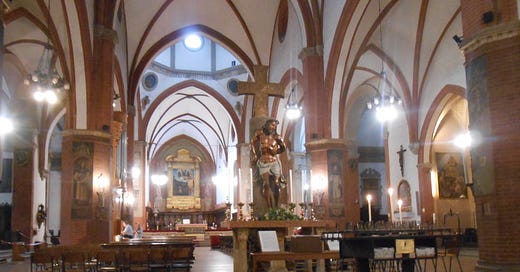


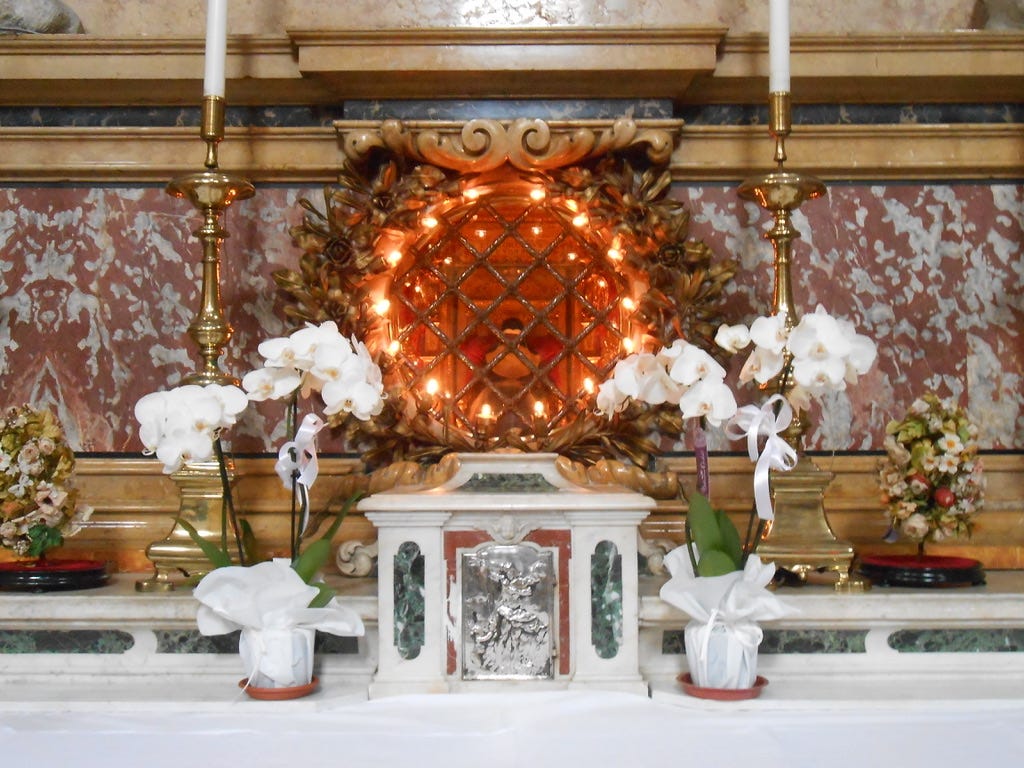
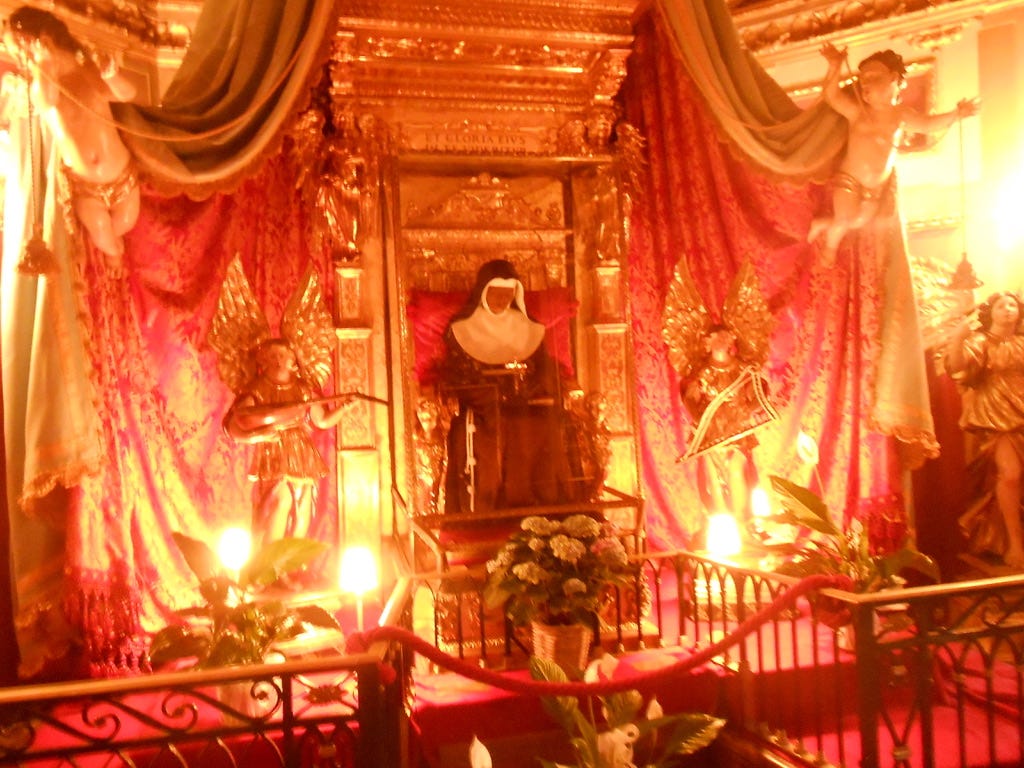
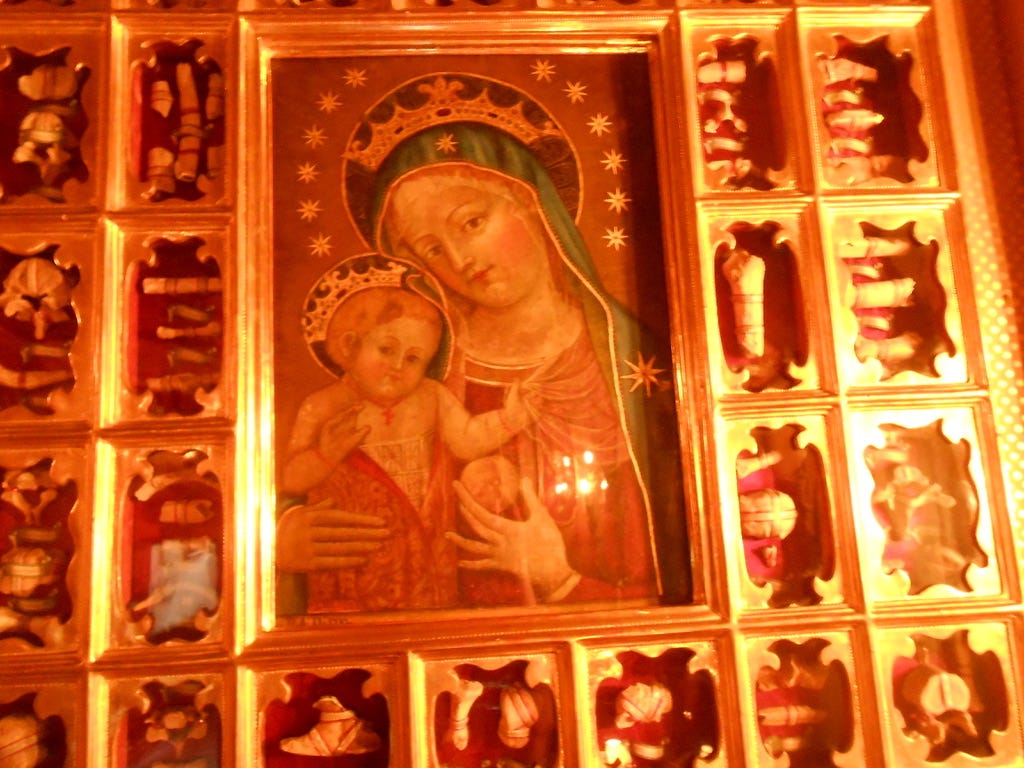
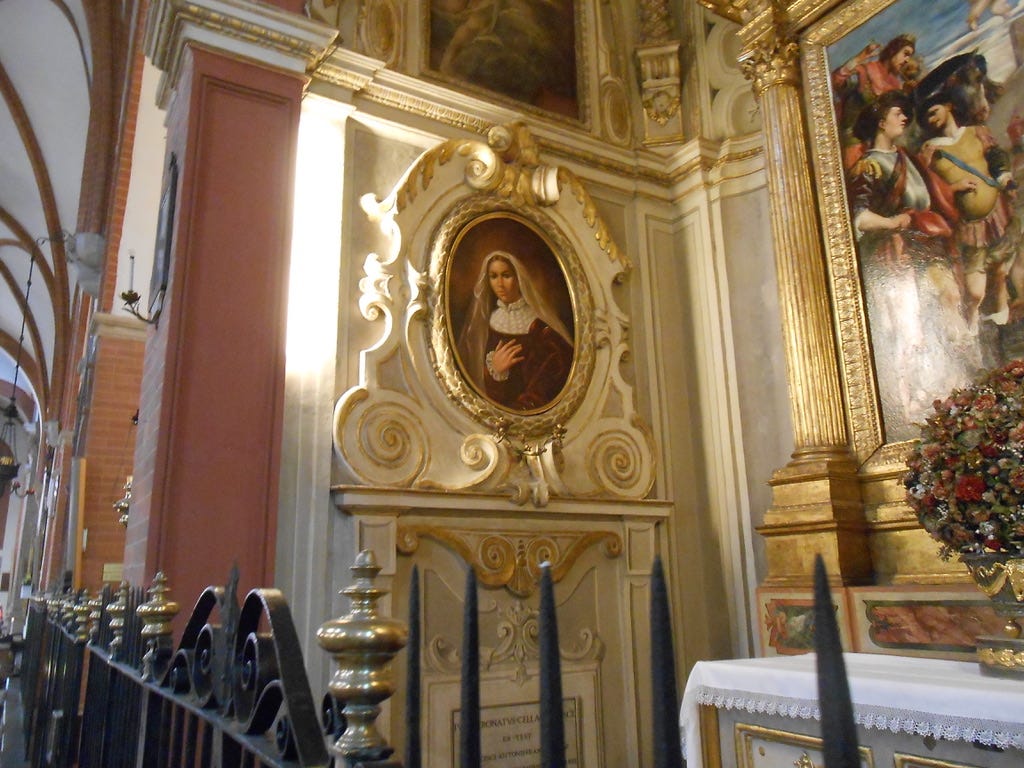
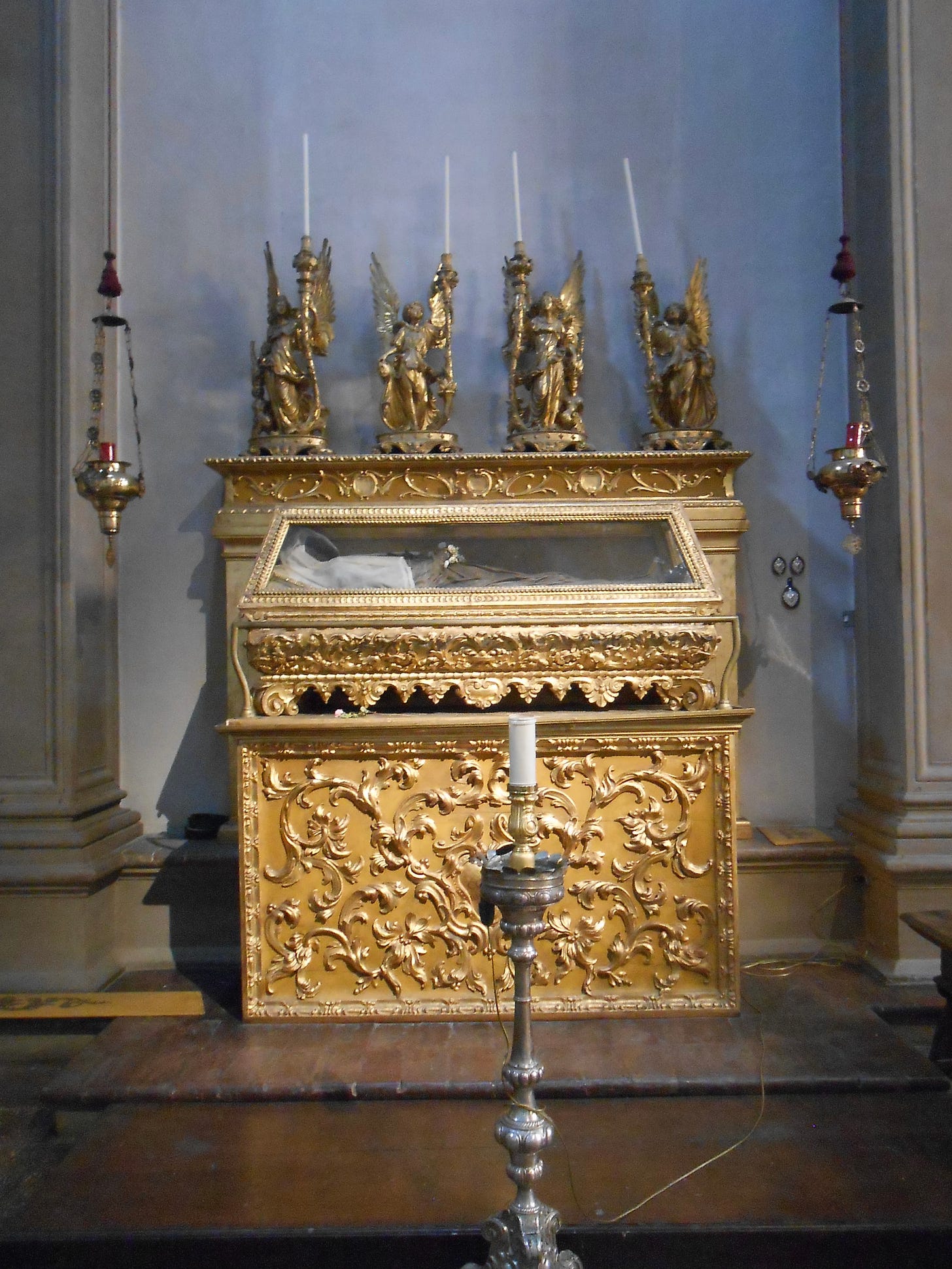

I HAVE SUBSCRIBED